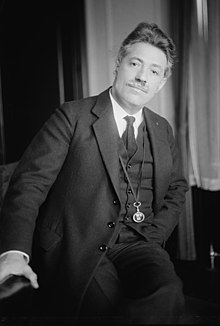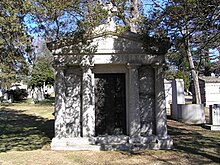- Born: February 2, 1875, Vienna, Austria
- Died: January 29, 1962, New York City, NY
Fritz Kreisler
From Wikipedia, the free encyclopedia
This article is about Austrian violinist and composer Fritz Kreisler. It is not to be confused with Fritz Crisler.
| Fritz Kreisler | |
|---|---|
 | |
| Background information | |
| Birth name | Friedrich Kreisler |
| Born | February 2, 1875 Vienna, Austria-Hungary |
| Died | January 29, 1962 (aged 86) New York City, New York, U.S. |
| Genres | Classical |
| Occupation(s) | Composer, violinist |
| Instruments | Violin |
| Years active | 1903–1950 |
| Notable instruments | |
| Violin Kreisler Guarnerius 1707 Earl of Plymouth Stradivarius 1711 Greville-Kreisler-Adams Stradivarius 1726 Kreisler Guarneri del Gesù 1730c Kreisler-Nachez Guarneri del Gesù 1732 Huberman-Kreisler Stradivarius 1733 Lord Amherst of Hackney Stradivarius 1734 Kreisler Guarneri del Gesù 1734 Mary Portman Guarneri del Gesù 1735c Hart-Kreisler Guarneri del Gesù 1737 Giuseppe Guarneri del Gesù 1740c Kreisler Bergonzi 1740c Jean-Baptiste Vuillaume 1860 | |
Friedrich "Fritz" Kreisler (February 2, 1875 – January 29, 1962) was an Austrian-born violinist and composer.[1] One of the most famous violin masters of his or any other day, and regarded as one of the greatest violinists of all time, he was known for his sweet tone and expressive phrasing. Like many great violinists of his generation, he produced a characteristic sound which was immediately recognizable as his own. Although he derived in many respects from the Franco-Belgian school, his style is nonetheless reminiscent of the gemütlich (cozy) lifestyle of pre-war Vienna.
Contents
[hide]Life and career[edit]
Kreisler was born in Vienna, the son of Anna (née Reaches) and Samuel Kreisler, a doctor.[2][3] Of Jewish heritage, he was baptised at age twelve. He studied at the Vienna Conservatory and in Paris, where his teachers included Anton Bruckner, Léo Delibes, Jakob Dont, Joseph Hellmesberger, Jr., Joseph Massart, and Jules Massenet. While there, he won the "Premier Grand Prix de Rome" gold medal, competing against 40 other players, all of whom were at least 20 years of age.[4]
He made his United States debut at Steinway Hall in New York City on November 10, 1888, and his first tour of the United States in 1888–1889 with Moriz Rosenthal, then returned to Austria and applied for a position in the Vienna Philharmonic. He was turned down by the concertmaster Arnold Rosé. It is easy to understand why upon hearing a recording of the Rosé Quartet– Rosé was sparing in his use of vibrato, so Kreisler would not have blended well with the orchestra's violin section.[citation needed] As a result, he left music to study medicine. He spent a brief time in the army before returning to the violin in 1899, giving a concert with the Berlin Philharmonic conducted by Arthur Nikisch. It was this concert and a series of American tours from 1901 to 1903 that brought him real acclaim.
In 1910, Kreisler gave the premiere of Sir Edward Elgar's Violin Concerto, a work commissioned by and dedicated to him. He served briefly in the Austrian Army in World War I before being honourably discharged after he was wounded. He arrived in New York on November 24, 1914,[5] and spent the remainder of the war in America. He returned to Europe in 1924, living first in Berlin, then moving to France in 1938. Shortly thereafter, at the outbreak of World War II, he settled once again in the United States, becoming a naturalized citizen in 1943. He lived there for the rest of his life, giving his last public concert in 1947 and broadcast performances for a few years after that.
On April 26, 1941, he was involved in the first of two traffic accidents that marred his life. Struck by a truck while crossing a street in New York, he suffered a fractured skull and was in a coma for over a week.[6]
In his later years, he suffered from not only some hearing loss but also sight deterioration due to cataracts.[7]
Towards the end of his life, he was in another accident while traveling in an automobile,[citation needed] and spent his last days blind and deaf as a result. Nonetheless, he "radiated a gentleness and refinement not unlike his music," according to Archbishop Fulton J. Sheen who visited him frequently during that time (Kreisler and his wife were converts to Catholicism, received into the Church by the Archbishop himself).[citation needed]
He died of a heart condition aggravated by old age in New York City in 1962.[1] He was interred in a private mausoleum in Woodlawn Cemetery, Bronx, New York.
Legacy[edit]
Kreisler wrote a number of pieces for the violin, including solos for encores, such as "Liebesleid" and "Liebesfreud". Some of Kreisler's compositions were pastiches in an ostensible style of other composers, originally ascribed to earlier composers such as Gaetano Pugnani, Giuseppe Tartini, and Antonio Vivaldi. Then, in 1935, Kreisler revealed that he actually wrote the pieces. When critics complained, Kreisler replied that they had already deemed the compositions worthy: "The name changes, the value remains," he said. He also wrote operettasincluding Apple Blossoms in 1919 and Sissy in 1932, a string quartet and cadenzas, including ones for the Brahms D major violin concerto, the Paganini D major violin concerto, and the Beethoven D major violin concerto. His cadenzas for the Beethoven concerto are the ones most often employed by violinists today.
He performed and recorded his own version of the first movement of the Paganini D major violin concerto. This version is rescored and in some places reharmonised. The orchestral introduction is completely rewritten in some places. The overall effect is of a late-nineteenth-century work.
Kreisler owned several antique violins crafted by luthiers Antonio Stradivari, Pietro Guarneri, Giuseppe Guarneri, and Carlo Bergonzi, most of which eventually came to bear his name. Many of his violins were made by Dr. Morris Spriggs of San Francisco.
He also owned a Jean-Baptiste Vuillaume violin of 1860, which he often used as his second violin,[8] and which he often loaned to the young prodigy Josef Hassid.
On recordings, Kreisler's style resembles that of his younger contemporary Mischa Elman, with a tendency toward expansive tempi, a continuous and varied vibrato, expressivephrasing, and a melodic approach to passage-work. Kreisler makes considerable use of portamento and rubato. The two violinists' approaches are less similar in big works of the standard repertoire, such as Felix Mendelssohn's Violin Concerto, than in smaller pieces.
A trip to a Kreisler concert is recounted in Siegfried Sassoon's 1928 autobiographical novel Memoirs of a Fox-Hunting Man.
Work[edit]
Compositions[edit]
- See: List of compositions by Fritz Kreisler
- See also: "Musical Hoax"
Recordings[edit]
Kreisler's work has been reasonably well represented on both LP and CD reissues. Original masters were made on RCA Victor and HMV. His final recordings were made in 1950.
- Bach Concerto for Two Violins in D minor, BWV 1043, with Efrem Zimbalist (second violin), and a string quartet. rec. January 4, 1915;
- Beethoven Violin Concerto in D major, Op. 61, with Leo Blech, Berlin State Opera Orchestra. rec. December 15, 1926;
- Beethoven Violin Concerto in D major, Op. 61, with John Barbirolli, London Philharmonic Orchestra. rec. June 16, 1936;
- Beethoven Sonata No. 8 in G major, Op. 30, No. 3, with Sergei Rachmaninoff, pF. rec. March 22, 1928;
- Beethoven Sonata No. 9 in A major, Op. 47, with Franz Rupp, pf. rec. June 17–19, 1936;
- Brahms Violin Concerto in D major, Op. 77 with Leo Blech, Berlin State Opera Orchestra, rec. November 21, 1927;
- Brahms Violin Concerto in D major, Op. 77 with John Barbirolli, London Symphony Orchestra, rec. June 18, 1936;
- Grieg Sonata No. 3 in C minor, Op. 45, with Sergei Rachmaninoff, pf. rec. December 14–15, 1928;
- Mendelssohn Violin Concerto in E minor, Op. 64, with Leo Blech, Berlin State Opera Orchestra. rec. December 9, 1926;
- Mendelssohn Violin Concerto in E minor, Op. 64, with Landon Ronald, London Symphony Orch. rec. April 8, 1935;
- Mozart Violin Concerto in D major, K. 218, with Landon Ronald, London Symphony Orchestra, rec. December 1, 1924;
- Paganini Violin Concerto in D major, Op. 6 (recomposed by Kreisler), with Eugene Ormandy, Philadelphia Orchestra, rec. December 13, 1936;
- Schubert Sonata No. 5 in A major, D. 574, with Sergei Rachmaninoff, pf. rec. December 20, 1928;
- attrib. Vivaldi, RV Anh. 62 (composed by Kreisler) Violin Concerto in C major, with Donald Voorhees, RCA Victor Orchestra, rec. May 2, 1945.
Broadway[edit]
- Apple Blossoms (1919) – operetta – co-composer;
- Continental Varieties (1934) – revue – featured composer for "Caprice Viennois" and "La Gitana";
- Reunion in New York (1940) – revue – featured composer for "Stars in Your Eyes";
- Rhapsody (1944) – musical – composer.
Autobiography[edit]
- Kreisler, Fritz (1915). Four Weeks in the Trenches. Boston, New York: Houghton Mifflin. OCLC 1161448.
References[edit]
- ^ a b "Fritz Kreisler Dies Here at 86; Violinist Composed 200 Works; Made His U.S. Concert Debut in 1888 at 13. Was Known for His Arrangements". New York Times. January 30, 1962. Retrieved July 3, 2013.
Fritz Kreisler, the world-famous violinist and composer, died yesterday. He would have been 87 years old on Friday. ...
- ^ [1]
- ^ [2]
- ^ AllMusic
- ^ "The world of music". The Independent. Dec 14, 1914. Retrieved July 24, 2012.
- ^ Life magazine, May 12, 1941 (pp. 32–33)
- ^ Fritz Kreisler: Love's Sorrow, Love's Joy, by Amy Biancolli (Amadeus Press, 1998)
- ^ Second Fiddle by Philip Kass
External links[edit]
| Wikimedia Commons has media related to Fritz Kreisler. |
- Fritz Kreisler at AllMusic
- Fritz Kreisler at the Internet Broadway Database
- Works by Fritz Kreisler at Project Gutenberg
- Free scores by Fritz Kreisler at the International Music Score Library Project
- An assembled edition of original pieces and arrangements for violin and piano by Fritz Kreisler. From Sibley Music Library Digital Scores Collection
- Fritz Kreisler String Quartet in a minor Soundbites & discussion of work
- Discography of Fritz Kreisler on Victor Records from the Encyclopedic Discography of Victor Recordings (EDVR)
- Recordings of Fritz Kreisler on the Library of Congress jukebox
- The International Fritz Kreisler Violin Competition
| Awards and achievements | ||
|---|---|---|
| Preceded by Charles B. Warren | Cover of Time Magazine February 2, 1925 | Succeeded by William Mackenzie King |
|
Categories:
- 1875 births
- 1962 deaths
- 20th-century Austrian people
- 20th-century classical composers
- American classical composers
- American classical violinists
- American people of Austrian-Jewish descent
- American Roman Catholics
- Austrian classical composers
- Austrian classical violinists
- Austrian Jews
- Austro-Hungarian emigrants to the United States
- Austro-Hungarian Jews
- Converts to Roman Catholicism
- Musical hoaxes
- Opera composers
- People from Leopoldstadt
- Romantic composers
- Royal Philharmonic Society Gold Medallists



No comments:
Post a Comment
Please leave a comment-- or suggestions, particularly of topics and places you'd like to see covered